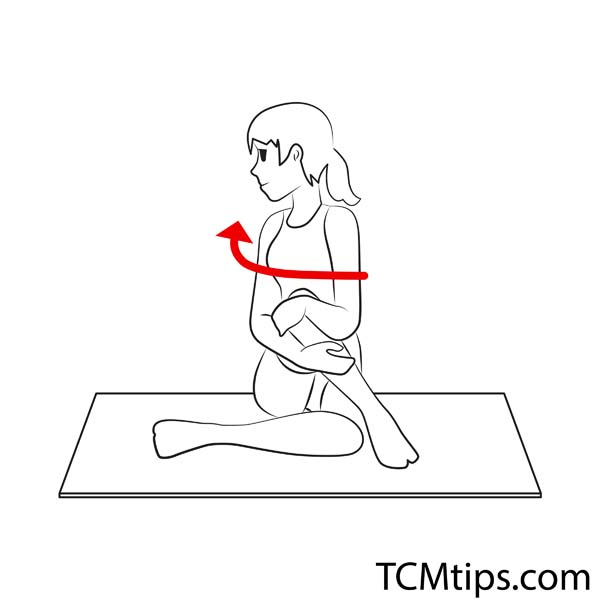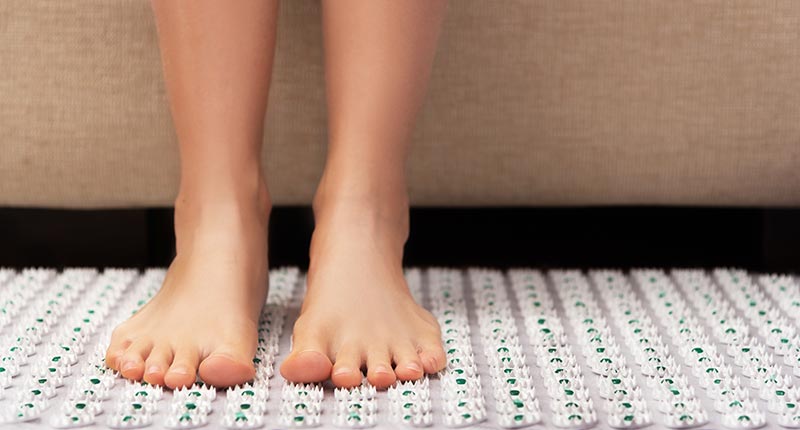If you are experiencing an intense sharp pain, which begins from the lower back to the thighs, you are most probably suffering from sciatica. Sciatica is very prominent today due to a change in our lifestyle, including sitting behind desks and working on computers or sitting at home watching tablets for a long time. All of these factors combined put constant pressure on the sciatic nerve leading to pain and other problems.
Fortunately, reflexology for sciatica can provide a tremendous amount of relief from the pain and discomfort caused by this disorder.
What Causes Sciatica?
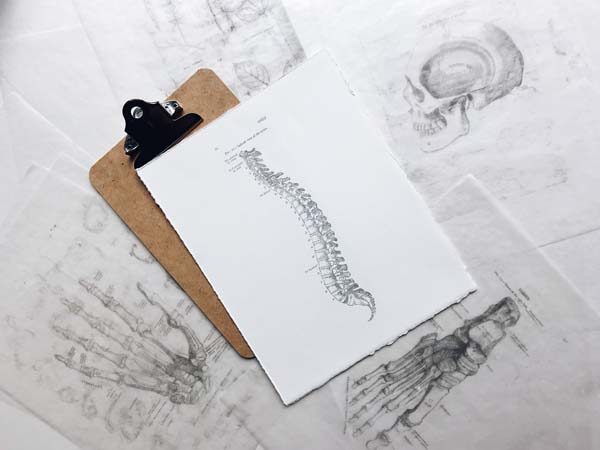 Sciatica is the term given to any form of pain induced by the sciatic nerve’s irritation or compression (the longest nerve in your body). The sciatic nerve travels through the rear of your pelvis, across your buttocks, all the way down both of your legs, and ends at your feet.
Sciatica is the term given to any form of pain induced by the sciatic nerve’s irritation or compression (the longest nerve in your body). The sciatic nerve travels through the rear of your pelvis, across your buttocks, all the way down both of your legs, and ends at your feet.
When the sciatic nerve is compressed or irritated, it can cause lower back and leg pain, numbness, and a tingling sensation that radiates from your lower back and travels down one of your legs to your foot and toes. The problem can vary from moderate to very severe and aggravated by sneezing, coughing, or sitting for an extended period. Some individuals with sciatica can also experience muscle weakness in the affected leg.
Sciatica is caused by a herniated or slipped disc in most cases. This is because when the disc that is present between the bones of the spine (the vertebrae) gets damaged, it starts pressing the sciatic nerve.
By adopting a better posture and following proper lifting techniques at work, stretching before and after any physical activity, and exercising regularly, you can lower your chances of developing a slipped disc and protect your back from injury and sciatica.
Reflexology For Back Pain And Sciatica
Reflexology for sciatica, also known as zone therapy, is a natural form of treatment that has been a part of traditional Chinese medicine (TCM) for more than 5000 years. It is also a core component of Ayurveda (an eastern form of treatment). You can also perform reflexology at home by stimulating specific pressure points on the hands and feet.
Reflexology is most often linked with the feet but can also include treatment on the hands and ears. The therapy system theorizes that zones on the hands, feet, and ears are connected with different internal organs and energy pathways (meridians) throughout the body.
Sciatic pain causes the contraction of muscles in the affected and surrounding area. Contracted muscles lead to more pain, which in turn causes our muscles to contract more. Our body goes into a constant cycle of pain and contraction, which just doesn’t seem to end.
This is where reflexology comes in. Reflexology for sciatica aims to benefit the person’s nervous system by promoting a deep state of relaxation, reducing stress levels, and helps relieve sciatica by relaxing the body and muscles.
Treating various reflex points on your feet can help calm the nerves, promote your body’s natural anti-inflammatory system, help spinal flexibility, and ease pain from sciatica.
Consider reflexology to reduce the inflammation in your spine and relieve your sciatic pain.
How To Relieve Sciatic Back Pain Through Reflexology
 Sciatica causes lower back pain. Luckily, you can adopt some effective reflexology techniques to find both short-term and long-term relief from your lower back pain.
Sciatica causes lower back pain. Luckily, you can adopt some effective reflexology techniques to find both short-term and long-term relief from your lower back pain.
Try stimulating these reflexology points for lower back pain in the following method to find relief from your back pain:
Step 1
You can alleviate your lower back pain by putting pressure on the reflex points present on the soles of your feet, the entire area surrounding your heel and ankle, and the inside edge of each foot. The reflex points for your spine are positioned around the inside edges of your feet.
You can treat your back pain by stimulating the specific reflexology points for your shoulders and back, which can be found on the sole and the upper area of your feet just beneath the base of your toes.
Step 2
The reflexology points for lower back pain and the sciatic nerve are found just behind your ankle bone and travels up in a straight line for about 4″ or 10 centimeters (3.9 in). Sciatica causes a sharp pain that moves down the leg due to the nerves’ compression, which can be triggered by several factors. Stimulating the sciatic nerve reflex points daily for a few minutes can help prevent sciatica and improve blood flow in this region.
Using the index finger and thumb, place gentle pressure on the sciatic nerve reflex points. Move your finger and thumb up and down, bringing them close and then moving them apart to ease your back pain.
Related reading: You Will Never Thought That Knowing Foot Pressure Points Diagram Could Be So Beneficial For Your Health!
Acupressure Points For Sciatica
For enhanced treatment, you can complement foot reflexology for sciatica with acupressure. Acupressure uses more than 400 acupoints that are located along the meridians that run throughout the body. This natural therapy is beneficial for treating sciatica.
You can stimulate specific acupressure points present on different meridians of your body to balance the flow of energy and alleviate sciatica’s discomfort. Acupressure is useful in treating a variety of health conditions. That’s why it is becoming popular day by day.
Acupressure falls under the category of complementary or alternative medicine that incorporates the principles of TCM.
This technique is based on the notion that the body’s core energy passes across meridian points on the body that connects to multiple organs, transfers energy, and contributes to optimal well-being.
Acupressure uses steady pressure and massage to stimulate the acupoints using the thumb or fingertips and is a pain-free treatment method. It can treat various disorders, including allergies, depression, inflammation, nausea, headaches, migraines, and foot issues. You can also perform acupressure on your own by learning this technique.
Here are some of the top acupressure points for sciatica:
Acupoint: SI-11 (Other Names: Small Intestine-11/Tian Zong/Heavenly Gathering)

Tian Zong or Sl-11 is located in the scapula region, in a depression at the center of the subscapular fossa at the 4th thoracic vertebra level. You can find this point by placing your band on the opposite side of the shoulder, and the acupoint is just below your middle finger. This is a great point to relieve sciatic pain, arm, and shoulder pain.
You can stimulate this point yourself with a tennis ball’s help, which you can place around this acupoint while leaning against the wall. Move your body back and forth, left and right to press the tennis ball on the Tianzong acupoint and the surrounding locations for about 30 seconds on each side, 5-10 times a day for relief.
Acupoint: GB-39 (Other Names: Gallbladder-39/Xuan Zhong/Suspended Bell)
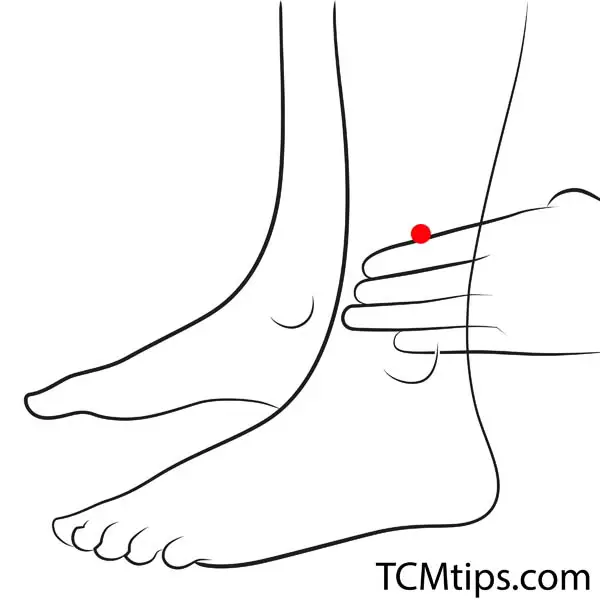
To stimulate this point, press this point towards the inner side of the bones. If it causes a slight pain, you can also apply a heat patch or a warm towel to this acupoint to find relief.

Acupoint: GB-31 (Other Names: Gallbladder-31/Feng Shi/Wind Market)
 Fengshi or GB-31 can be found on the centerline of the lateral part of the thigh and seven cun above the transverse popliteal crease. When standing with the arms hanging down the sides, you can find it near the tip of your middle finger at the point where it touches your legs.
Fengshi or GB-31 can be found on the centerline of the lateral part of the thigh and seven cun above the transverse popliteal crease. When standing with the arms hanging down the sides, you can find it near the tip of your middle finger at the point where it touches your legs.
This point is handy for treating lateral and posterior leg problems, particularly sciatica, and helps alleviate the lower limbs’ weakness and numbness.
Using your little knuckle, tap or press this point 15 to 30 times for relief.
Acupoint: GB-30 (Other Names: Gallbladder-30/Huan Tiao/Jumping Circle)
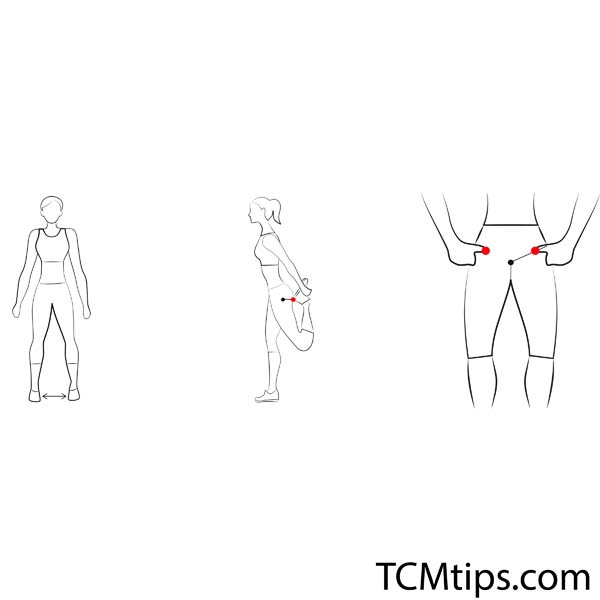
This point can be found on the line between the greater trochanter and the sacrococcygeal hiatus, 1/3rd of the way from the greater trochanter.
According to TCM, the blockage of energy in the body causes sciatica. The Huantiao acupoint is believed to benefit the waist and legs and clear the pathways associated with these areas. Many people had found great success when they stimulated the Huantiao point for 15 consecutive days.
Related Reading: Does Acupuncture Work For Sciatic Nerve Pain? This Is What I Learn From A Licensed Acupuncturist
Try These Exercises To Help Alleviate Sciatic Pain
If you are doing an office job, then you most probably don’t have time for exercise due to your busy schedule. Sitting all day at the workplace carries several negative health consequences. Constant pressure on the buttocks or the hip abductor muscles, including the gluteus medius, gluteus minimus, and tensor fasciae latae, leads to stiffness and hardening of this specific muscle group.
Bonus: The 6 Best Acupoints, Including GV 16 Acupuncture Point, For Any Office Worker
The sciatic nerve runs through these three muscles, which connect the pelvis with the thighs.
So, if the hip abductor muscles become stiff, they can compress the sciatic nerve resulting in sciatic pain or other symptoms related to sciatica.
If you want to get relief from your sciatic pain, try performing the following exercises at home or in the office to soften or release these muscles’ stiffness.
You can efficiently perform these exercises every day while sitting to restore the softness of the hip abductor muscles to find relief from sciatic pain or even prevent sciatica from developing in the first place.
Exercise No.1

- While sitting on a chair with stable legs, raise your right foot or leg and place it on top of your left thigh as you usually do.
- Then hug your right knee with your left hand and move closer to your chest while your right-hand twists behind you. Remember that the buttocks must be placed on the chair at all times and should not be lifted during this process. Your back should also be pressed against the back of the chair to increase the range of rotation. Do this entire process for about 20 to 30 seconds, switch to the left leg, and perform the same procedure again.
Exercise No.2
- While sitting cross-legged on the floor, raise your right foot and step on the outer side of your left knee.
- Hug your right knee tightly while turning to the back. Do this procedure for 20-30 seconds, then perform the same process on the legs’ left side.
Exercise No.3
- While lying on the floor on your belly, use your right hand to hold a towel and wrap it around your right foot.
- Try to pull the right foot to the other side so that the side of the knee can be as close to the floor as possible. Do this for each side of the leg for at least 20 to 30 seconds.
These three exercises are very effective in treating the symptoms of sciatica. You will feel a reduction in your sciatic pain and discomfort if you perform 2 to 3 sets of these exercises every day.
Stretching Exercises while sitting in the car
If you are experiencing back pain or sciatica symptoms due to sitting in the car for long hours due to your hectic work schedule, you can try these stretching exercises in the limited space of your car.
Here are the three stretching exercises to alleviate muscle stiffness and sciatic pain.
Stretching Exercise No. 1
- Stretch your arms behind your back while holding both hands, tilt your head backward slowly and try to expand your chest. Hold for a few seconds, and then come back to your everyday posture. This can help alleviate your neck and back pain. Repeat this process at least five times.
- While doing this stretch, don’t fold your back. Try to keep your back straight when you stretch your hands and tighten your belly.
Stretching Exercise No.2
Fold your arm and pull your elbow gently behind your back. Hold this position for at least 15 seconds and then do the same with the other arm. Repeat this procedure three times to find relief from your sciatic and back pain.
Stretching Exercise No.3
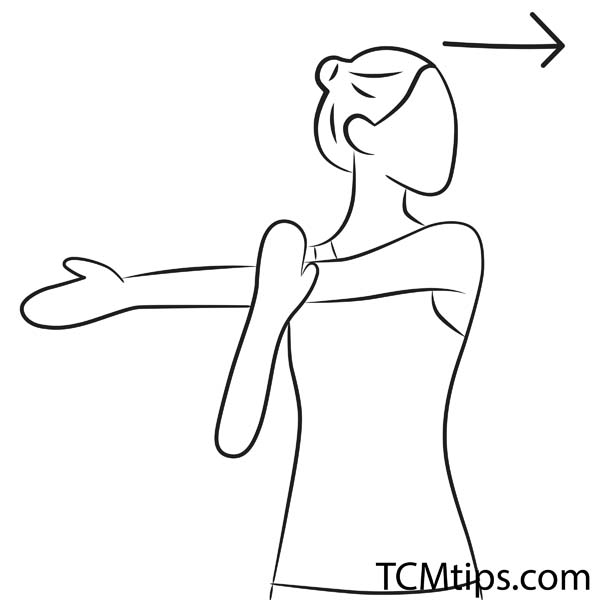
Bonus Tips: Sciatica Can Be Related To Kidney, Ovaries, Or Prostate Issues
If you are experiencing sciatica or sciatic pain on the left side, you may be having problems with your left kidney, ovaries, or prostate (in the case of men).
Here are some simple ways through which you can help improve your kidneys and ovaries and find relief from sciatica:
- Avoid all types of animal meat and broth that have been taken from animals who are fed and raised using growth hormones
- Avoid all types of foods that are made from fine flour
- Avoid all types of fried foods and products containing milk
Drink a juice made from nutritious vegetables
You can drink vegetable juice to help detox your body and get all the essential nutrients you need for optimal health. Take some Basili, coriander, green coconut juice, and water. Blend them all in the juicer to make a healthy juice. You can drink this juice every day to improve your kidney function.
Massage the ovarian reflex area to relieve pain
 You can massage the ovarian reflex area that is located behind the ankles with any good massage oil. Apply firm and steady pressure on these joints for at least 2 minutes, twice a day for relief.
You can massage the ovarian reflex area that is located behind the ankles with any good massage oil. Apply firm and steady pressure on these joints for at least 2 minutes, twice a day for relief.
Restore the balance of energy and nutrition in the body
Add some sea salt to a large cup of warm water, drink it every day to support your nervous system, and promote blood circulation and better brain function. You can also take a quinoa supplement to boost your central nervous system’s functioning and improve kidney function.
Try doing the magical waist movement
- Place your hands on any table that is lower than your knees in your living room.
- Then straighten back your legs and lie down straight on your stomach (face down).
- Use the movement of the waist to bend up and down. Do this process 15 to 20 consecutive times, then come back to your normal position.
- Stretch your right leg backward and lift it. Shake it vigorously for up to ten to twenty times. Repeat this process for the left leg. Do this procedure for at least four to five times in a row.
Conclusion
Sciatica is a painful disease that may be caused by compression of the sciatic nerve. Luckily, with the help of different natural approaches such as reflexology for sciatica, acupressure, and by promoting kidney health, you can manage the dreadful symptoms of sciatica and find long-term relief from this disorder.
Photo by Joyce McCown on Unsplash
 P. Sze
P. Sze 
